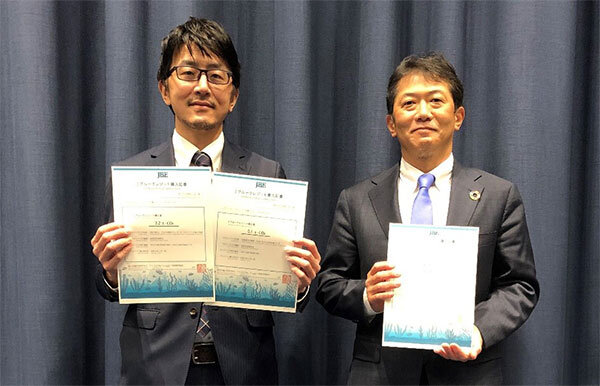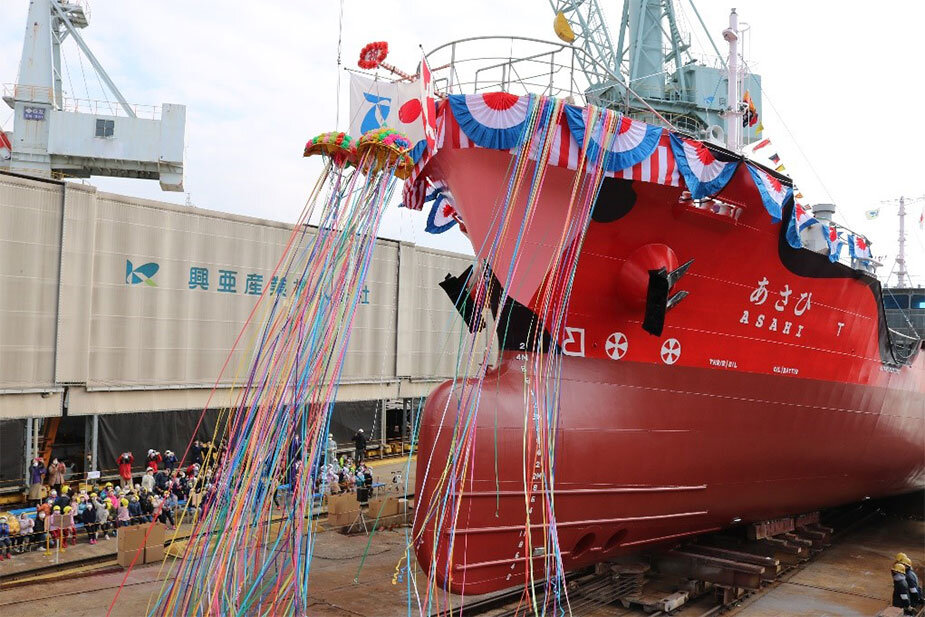- JP
- EN
MOL to Participate in 'J Blue Credit' Carbon Offset for Supporting Restoration and Conservation of Seagrass Meadow
- Offsetting CO2 Emissions from Repositioning World's 1st EV Tanker -
March 18, 2022
TOKYO-Mitsui O.S.K. Lines, Ltd. (MOL; President & CEO: Takeshi Hashimoto) today announced that it will participate in the carbon offset (Note 1) by using "J Blue Credit" (Note 2), which utilizes the blue carbon (Note 3), issued by Japan Blue Economy Association (JBE) (Note 4), an association approved by Ministry of Land, Infrastructure, Transport and Tourism.
The "J Blue Credit" targets blue carbon, which is carbon dioxide (CO2) absorbed by marine and coastal ecosystems such as seagrass meadow, and is attracting attention as a new credit aimed at accelerating steps to mitigate climate change.
The project began on a trial basis in fiscal year 2020, and in its second year, FY2021, credits were issued through restoration activities of seagrass meadow and tidal flats in Yokohama City, at the Port of Tokuyama Kudamatsu in Shunan City, and Hyogo Canal. Today, a ceremony for issuance of certificates was held for sellers and purchasers.

MOL will contribute to enhancing the implementation and sustainability of initiatives to restore and protect seagrass meadow in each area through purchase of credits for about 11 tons, among the total about 65 tons of credits issued. Blue carbon ecosystems such as seagrass meadow not only fix and absorb carbon, but also provide diverse benefits including food supply, water purification, and species conservation, supporting people's lives.
[Details of J Blue Credit Project and Credit]
| Project area | Kanazawa Ward, Yokohama City, Kanagawa Pref. | Port of Tokuyama Kudamatsu, Shunan City, Yamaguchi Pref. | Hyogo Canal, 4-1 Zaimoku-cho, Hyogo Ward, Hyogo Pref. |
|---|---|---|---|
| Project applicant | Yokohama City fisheries cooperative, Specified nonprofit corporation Association for Shore Environment Creation, Amamo Revival Collaboration in Kanazawa-Hakkei, Tokyo Bay Area | Yamaguchi Pref. fisheries cooperative, Shunan Administration Branch, Oshiama Higata wo sodateru kai (Association to Foster Oshima Tidal Flats), Shunan City | Hyogo Pref. fisheries cooperative, Hyogo Unga wo utsukushiku suru kai (Association to Beautify Hyogo Canal, Kobe City), Hamayama elementary school, Hyogo/Waterside network |
| Amount of credit issued | 19.4 tCO2e* | 44.3 tCO2e | 1.1 tCO2e |
| Amount of credit MOL purchased | 8.6 tCO2e | 2.2 tCO2e | 0.1 tCO2e |
* CO2e stands for CO2 (carbon dioxide) equivalents, and the amount, converted to carbon dioxide
MOL-purchased credits are planned to offset CO2 emitted from world's first zero emission electric tanker "Asahi" (Note 5), which is newly built by its group Asahi Tanker Co., Ltd. (Headquarters: Chiyoda-ku, Tokyo) and is slated to be delivered at the end of this month, will be repositioned from the shipyard in Marugame City, Kagawa Prefecture to Kawasaki City in Kanagawa Prefecture where the power supply facility is located. In the future, the vessel will contribute to CO2 reduction of about 280 tons, 60% (Estimated values) annually compared to conventional vessels by using renewable energy-derived electricity. MOL strives to expand its use of electric propulsion (EV) vessels in coastal shipping in cooperation with Asahi Tanker.
The MOL Group engages in creation of negative emissions (Note 6) including blue carbon, in cooperation with various stakeholders, with the aim of achieving net zero emissions targeting all of scope 1, 2, and 3 by 2050, as stated in the "MOL Group Environmental Vision 2.1" (Note 7) established in June 2021. In this way, it will ensure a prosperous future from the blue ocean, by contributing to the sustainable growth of people, society and the planet, for all life living in the next generation.
(Note 1) Carbon offset
Adjusting unavoidable emissions after efforts on CO2 reduction to achieve net zero, by offsetting them through purchase of CO2 reduction and absorption amounts by others.
(Note 2) J Blue Credit
An unique credit, issued and managed by JBE, through examination/certification opinions by an independent third-party committee. JBE conducts research and development related to system design and so on toward certification and issuance of "J Blue Credit" as a new credit, with the goal of enhancing the role of blue carbon ecosystems as CO2 sinks and accelerating initiatives on climate change adaptation and mitigation in the ocean and coastal areas. For details, please refer to https://www.blueeconomy.jp/en/
(Note 3) Blue carbon
Blue carbon is derived from CO2 sequestrated and stored by marine ecosystems such as mangroves, seagrass meadows, and salt marshes. It was defined for the first time in a report by the United Nation's Environmental Programme (UNEP) in October 2009, and along with "green carbon," which is derived from CO2 absorbed by terrestrial forests and so on, is drawing attention as nature-based negative emission (Note 7).
(Note 4) Japan Blue Economy Association
Ministry of Land, Infrastructure, Transport and Tourism-approved technical research association, established in July 2020, with the aim of promoting climate change countermeasures in coastal areas, and conducting experiments and research such as quantitative evaluation of blue carbon (Note 2) and introduction of technical research and funding mechanisms.
(Note 5) Zero emission electric propulsion tanker "Asahi"
It is a newbuilding EV tanker (499 gross tons) of Asahi Tanker Co., Ltd., and realizes the "e5 Tanker" planned and designed by e5 Lab Inc. (Headquarters: Chiyoda-ku, Tokyo). The first vessel, the Asahi, is slated for delivery at KOA Industry Co., Ltd. (Headquarters: Marugame-shi, Kagawa Prefecture) at the end of March 2022. The second vessel will be constructed at Imura Zosen Kabushiki Kaisha (Headquarters: Komatsushima-shi, Tokushima Prefecture) and is slated for delivery in March 2023.

(Note 6) Negative emission
The term "negative emissions" refers to removing and storing CO2 from the atmosphere. There are two main categories-nature-based solutions that increase CO2 absorption in nature such as forests and blue carbon; and technology-based solutions that removeCO2 from the atmosphere by using chemical engineering technologies
(Note 7) MOL Group Environmental Vision 2.1
https://mol.disclosure.site/en/themes/101

